Copper pipes for gas: specifics and standards for laying a copper pipeline
For the installation of gas pipelines, pipes made of various materials are used: HDPE, steel and copper.Polymer products are used only for underground installations; steel wiring is installed inside houses and apartments.
Today, when the quality of the metal has improved and it has become possible to produce products of the required thickness and length, copper pipes for gas are increasingly being installed. They are excellent for low-pressure gas pipelines and have suitable characteristics in terms of strength, flexibility and wear resistance.
If you decide to assemble an in-house gas pipeline yourself, it would be a good idea to take a closer look at the properties of pipes and press fittings made of copper, and learn more about assembly methods and the requirements for the products.
The content of the article:
What are the requirements for copper pipes?
Companies that produce products for gas pipeline installation never use copper alloys with other materials in their production, as the quality is lost. The purity of the metal should not be lower than 99.9%.
Brands used for making pipes:
- at domestic enterprises - M1, M2, M1r, M2r;
- foreign analogues – Cu-DHP.
Depending on the production method and physical properties, finished products are divided into 3 categories: soft (R - tensile strength 220 mPa), semi-hard (R - tensile strength 250 mPa), hard (R - tensile strength 290 mPa).

It has been noticed that long-term storage affects the quality of copper - it becomes harder. You can return to its former qualities by annealing. In order not to carry out additional restoration measures, we do not recommend purchasing installation products with a reserve.
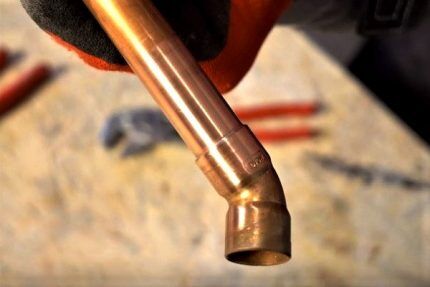
According to manufacturing technology, gas pipes are divided into 2 groups:
- welded - in the production of which welding is used, therefore, there are seams;
- seamless - monolithic, seamless products.
It is preferable to use the second group, since the seams will always be areas from the risk zone, that is, they will have reduced characteristics in terms of tightness.
In addition to the usual copper pipes and fittings They also produce products with an outer shell made of polymer materials - PVC or foamed polyethylene. The advantages of such products are additional external protection and a kind of camouflage.
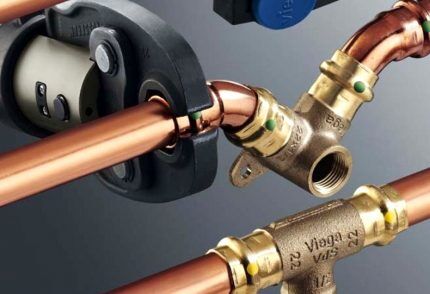
Sewing a copper gas pipeline into a concrete wall or hiding it behind drywall is prohibited by law.
Standards and regulations
The gas pipeline is a structure that poses a potential danger to the residents of the house, therefore both production and installation work are subject to the requirements set out in the regulatory documentation.
The basis for modern sets of rules were the norms of 1987 - SNiP 2.04.08-87.
Currently, information of interest on copper pipelines can be found in the following documents:
- SP 42-101-2003 – on the design and construction of gas distribution systems;
- SNiP 42-01-2002 – norms and rules of the State Registration Service;
- OST 153-39.3-051-2003 – operation of gas distribution stations.
Along with the main documents, you should study additions and clarifications that appear periodically in connection with the development of technology and the release of new products. Let's assume that SNiP 42-01-2002 was amended in 2011 and supplemented with materials, including requirements for copper products. New edition – SP 62.13330.2011.
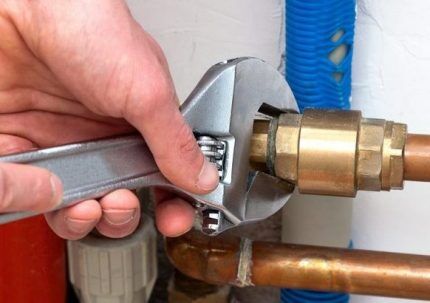
The rules for installing structures made of copper gas pipes should also be added to the general requirements. An example of such a document is the STO “Design, installation and operation of gas pipelines from copper pipes for gasification of residential and public buildings,” which examines in detail the nuances of gas pipeline assembly and requirements for pipes.
[adinserter name=”mobile: insert in text -3″]More information about the requirements for copper pipes and fittings can be found in the following documents:
- GOST 617-90;
- GOST 859-78;
- GOST R 52318-2005;
- EN1057 – European standards;
- GOST R 52948-2008;
- GOST R 52922-2008;
- GOST R 52949-2008.
We warn you that if you use products that do not meet legally valid requirements, the operation of the gas pipeline becomes dangerous.
Recommendations for recruitment
Involving amateurs in installation work is not the best solution.We advise you to contact a company that has been installing in-house gas pipelines for a long time and has experienced gas system installers.
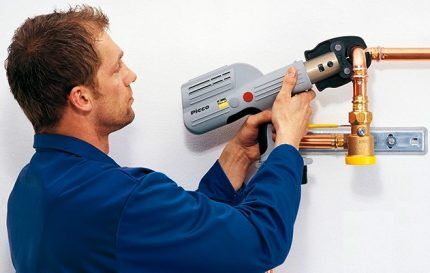
The qualifications of workers are documented, so you have the right to request a certificate.
Specialists who have received the 4th category and higher according to OK 016 are allowed to solder or weld. The conclusion is given by the certification commission, based on the rules RD 03-495-02 and PB 03-273-99.
Crimping can be carried out by workers with the 3rd category and above who have experience in assembling copper gas pipelines and have passed certain tests. To obtain permission to practice, the performer must make at least 3 high-quality connections with press fittings tested by the commission. Control of the work performed is determined according to the rules of SNiP 3.01.01.
Features of assembling a copper gas pipeline
The assembly and connection of copper pipes for an intra-house gas pipeline differs from the installation work carried out with other types of products - for example, polymer or steel.
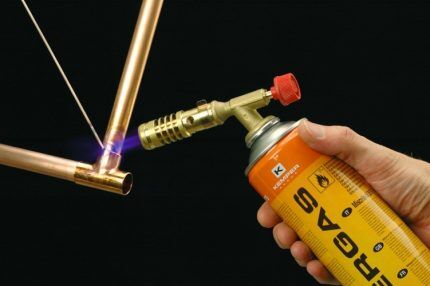
Hard solder is used without flux; popular materials include PMFOTSr6-4-0.03 and PMFS6-0.15 - copper-phosphorus compounds.
If soldering is used advantageously for intra-house wiring, then at the entrance to the house, where large-diameter pipes are installed, connecting work is performed using argon arc or gas welding.
Other rules for installation work on a copper gas pipeline:
Plastic brackets and other fasteners made of polymers are prohibited. If grooves are cut out to arrange internal wiring, they cannot be closed from the outside, and the space around the pipes in the groove must be free.
Pipe Installation Instructions
Gas pipeline installation includes 3 stages:
- design;
- pipe preparation;
- installation.
At the end, a test run is performed and the pipeline is checked for leaks.
We will analyze the main methods of preparing parts for installation - bending and cutting, as well as two popular methods of connecting pipes - pressing and soldering.
How to cut and bend copper
Before the beginning installation work pipes must be prepared.Completely straight gas pipelines are rarely found; more often they consist of combinations of straight and bent elements. This means that the pipe material must be cut, and some parts must be carefully bent at a given angle, 90° or obtuse.
For cutting, you can use a hacksaw, a circular electric saw, but the most acceptable tool is a pipe cutter.
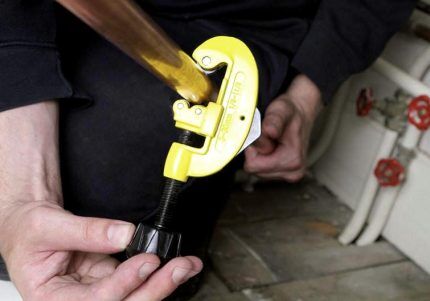
During the cutting process, make sure that the pipe does not deform - any bulges, cracks or dents will pose a threat to the tightness of the gas pipeline.
Bending can be done cold or hot. The first is used for thin pipes, more often used in everyday life, with a diameter of up to 22 mm. The hot method is used for products with large diameters. The pipe is heated by filling the bend with sand. This is necessary so that there are no creases.
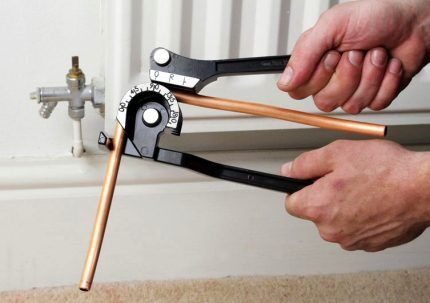
For heating, experienced craftsmen use a torch, acetylene-oxygen or acetylene-air. Operating temperature – from +650°С. The readiness of copper is determined by its shade: as soon as it turns dark red, it can be bent. The procedure is carried out quickly but carefully.
Connection methods: crimping and soldering
If you have time, developed skills and experience, you can try to solder copper pipes yourself. This method takes longer than crimping, but is inexpensive and reliable.

Procedure:
- Preparation of parts: cutting and bending pipes, if necessary, flaring and calibration.
- Cleaning the ends of the joined sections, eliminating any defects.
- Inserting the end of one pipe into the flared end of another.
- Warming up the soldering area to the melting temperature of the solder.
- Injecting solder into the gap between two parts.
- Cooling the soldering area and cleaning the joint to a shine.
After soldering is completed, diagnostics are performed. Testing for the tightness of the system is carried out by a special commission.
Connection using press fittings is a reliable modern method, the main advantage of which is the fast speed of gas pipeline assembly.
Instructions for connecting pipeline elements by pressing:
If your hand is full, then when assembling a small fragment, first connect several elements with fittings, and then crimp them in one go. It is recommended to assemble the in-house gas system in parts - first, separately complex sections with a large number of bent elements, and then putting them together.
Collet-type (crimp) fittings are also used to connect copper pipes, which are practically not used in the assembly of gas pipelines due to the not very high reliability of the dismountable unit. The most reliable connections are those formed by soldering.
However, to implement soldering copper pipes you need experience and the appropriate tools: a blowtorch for low-temperature connections, a propane or acetylene torch for high-temperature ones.
Conclusions and useful video on the topic
An example of installing a copper gas pipeline in a country house:
How to perform crimping with copper fittings:
About the advantages of replacing pipes with copper:
A home gas pipeline made of copper pipes is reliable and aesthetically appealing. It is considered one of the best options for installation in a private house or apartment. But, when planning to install a copper structure, do not forget about safety: if you do not have experience working with pipes, it is better to entrust the installation to specialists.
Do you want to share your own experience in assembling a pipeline from copper pipes? Do you have valuable information on the topic of the article that could be useful to site visitors? Please leave comments in the block below, ask questions about points of interest or controversial issues, and post photos.




Tell me, please, where can I get a certificate for engineers and workers on the technology of installing a copper gas pipeline using the crimping method?
I WOULD LIKE TO INVOLVE A SPECIALIST IN INSTALLING GAS PIPES AT THE COUNTRY, BUT ONLY ON YOUR RECOMMENDATION. HIGHLY APPRECIATE.